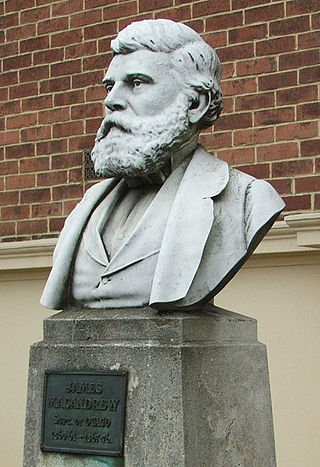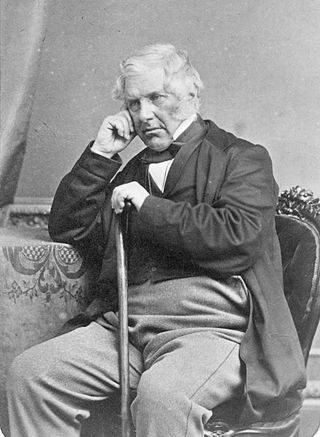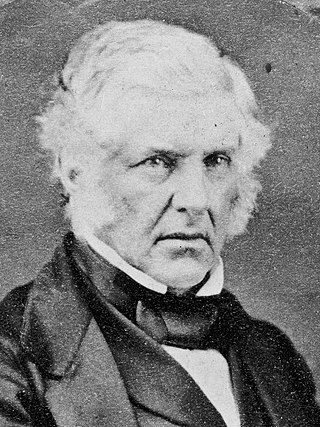
James Macandrew was a New Zealand ship-owner and politician. He served as a Member of Parliament from 1853 to 1887 and as the last Superintendent of Otago Province.

James Mackay was a New Zealand politician. He was a member of the 1st New Zealand Parliament. He is remembered for the incident with Henry Sewell in Parliament in 1854.

Thomas Houghton Bartley JP was an English p-born New Zealand politician.

Thomas Spencer Forsaith, JP, was a New Zealand politician and an Auckland draper. According to some historians, he was the country's second premier, although a more conventional view states that neither he nor his predecessor should properly be given that title.
James Frederick Stuart-Wortley JP was a politician in New Zealand and the UK. He was New Zealand's inaugural Baby of the House and remains the youngest member of parliament in the country's history; in fact he was too young to even be legally elected.

William Thomas Locke Travers was a New Zealand lawyer, politician, explorer, and naturalist.
William Oldfield Cautley was a New Zealand settler and politician.
The 2nd New Zealand Parliament was a term of the Parliament of New Zealand. It opened on 15 April 1856, following New Zealand's 1855 election. It was dissolved on 5 November 1860 in preparation for 1860–61 election. The 2nd Parliament was the first under which New Zealand had responsible government, meaning that unlike previously, the Cabinet was chosen by Parliament rather than by the Governor-General of New Zealand.

Charles Elliott was a New Zealand politician and newspaper proprietor.

The 1879 New Zealand general election was held between 28 August and 15 September 1879 to elect a total of 88 MPs to the 7th session of the New Zealand Parliament. The Māori vote was held on 8 September. A total of 82,271 (66.5%) European voters turned out to vote, plus 14,553 Māori voters. Following the election, John Hall formed a new government.

Nelson is a New Zealand parliamentary electorate, returning one Member of Parliament to the House of Representatives of New Zealand. From 1853 to 1860, the electorate was called Town of Nelson. From 1860 to 1881, it was City of Nelson. The electorate is the only one that has continuously existed since the 1st Parliament in 1853.
Samuel Stephens was a 19th-century surveyor and New Zealand politician.
Waimea was a parliamentary electorate in the Nelson Province of New Zealand, from 1853 to 1887. Initially represented by two members, it was a single-member electorate from 1861.
Richard Packer was a New Zealand politician and Member of Parliament from 1856–1859 representing the Town of Christchurch electorate. He was also a member of the Canterbury Provincial Council, including its treasurer.

The Sewell Ministry was the first responsible government in New Zealand. Unlike previous executives, its members were held accountable to Parliament. This would form the basis for future governments in New Zealand.
The 3rd New Zealand Parliament was a term of the Parliament of New Zealand. Elections for this term were held between 12 December 1860 and 28 March 1861 in 43 electorates to elect 53 MPs. Two electorates were added to this during this term, Gold Fields District and a new Dunedin electorate created by splitting the existing City of Dunedin into Dunedin and Suburbs North and Dunedin and Suburbs South, increasing the number of MPs to 57. During the term of this Parliament, six Ministries were in power.
The 4th New Zealand Parliament was a term of the Parliament of New Zealand.
The 1854 Town of Nelson by-election was a by-election held in the multi-member electorate of Town of Nelson during the 1st New Zealand Parliament, on 17 June 1854, and was the first by-election in New Zealand political history.
The 1854 Waimea by-election was a by-election held in the multi-member electorate of Waimea during the 1st New Zealand Parliament, on 21 June 1854, and was the second by-election in New Zealand political history, coming two days after the Town of Nelson by-election.

The 1865 Town of New Plymouth by-election was a by-election held in the Town of New Plymouth electorate during the 3rd New Zealand Parliament, on 19 May 1865. The by-election was caused by the resignation of the incumbent, Charles Brown, and was won unopposed by Henry Sewell. Whilst Sewell was not a local resident, he was a member of the government through his appointment to the Legislative Council, the upper house of Parliament. Sewell accepted the invitation to represent the electorate, as him becoming a member of the lower house was seen to strengthen the government.












